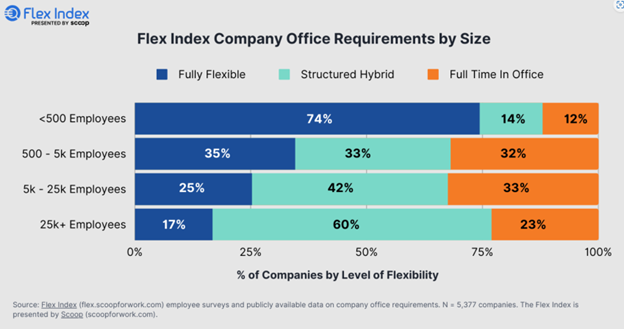Teleworking innovation peaked between 2020 and 2023. Today, it is deemed a workplace strategy widely practiced amongst employees with access to that option. Research suggests that about 50% of the labor force can have access to this solution when agreed upon by management and supported by sound policies. Data about teleworking and the type of employers receptive to it have plateaued in 2023, allowing us to answer ongoing questions about remote work, while identifying some key lessons learnt.
Lesson #1: Work flexibility yields positive results.
The 2023 Gallup survey revealed 52% of the employees are on a hybrid schedule (some days on site), 29% exclusively remote (five days per week), and only 22% on site every day. Flexible work schedules yield positive results for both employers and employees. Studies show, for employers the top three benefits are reduced burn-out, improved retention and greater productivity. The top three employee benefits are work/life improvements, greater efficiency in time management, and less burn-out.
Lesson #2: Telework programs by size and industry type
Despite the portrayal of a “return to work mandate,” many employers are successfully implementing and continuing to offer this great flexibility. Based on research from SCOOP, the largest group of employers that allow for teleworking are under 500 in size. The following chart depicts the employer size by offering of teleworking.

According to the 2018 Census, 46% of Americans worked for employers with less than 500 employees. The chart shows how the level of formality increases with the size of employer. The larger the employer size the more likely it is to ask employees to report to work a certain number of days and the actual day of the week. Most of the employees reported working on site on a Tuesday, Wednesday, or Thursday. Fridays are regarded as a “ghost-town” in most organizations. The larger organizations have a more complex structure and decision-making process. Overall middle-management tend to be more supportive of teleworking than upper management. The ladder for decision making in smaller organizations is also shorter.
Lesson #3: Office Occupancy Data Causes a Headache for developers and property-owners
Weekly data from Kastle, shows that office occupancy levels in the U.S. are at an average of 50% for 2023. This has caused much trepidation for building owners and developers. The lowest occupancy levels are experienced in the San Francisco and New York markets, while Dallas and Austin are around 60%. Some offices are redesigning their square footage for more work use or for conversational space. Some offices have managed to renegotiate their leases for both office and parking costs. A few developments have started an “adaptive us process” meaning that they are changing the usage of space from office to residential or retail. This can be expensive and, in some cases, not even possible.
Lesson #4: The stricter return to work policies is found in technology and larger firms
While a large number of people are still teleworking, some companies have implemented a strict “return to work” mandate, according to media channels. Many of those companies were technology firms that grew their employee population or department during the pandemic and laid them off after the pandemic. According to SCOOP, the top five labor categories most amenable for teleworking are the technology, professional services, media and entertainment, financial services, and insurance sectors.
Lesson #5: Apply new policies and program for the hybrid and remote workers
Given the flexibility today, employers should focus on strengthening the telework related tools. All employers need a policy for remote employees to make sure that their rights are preserved. There are many legalities established around teleworking that need to be observed, such as worker’s compensation, hours of work, reporting of sick days, etc. The policy also should include rules regarding equipment, connectivity, and key performance indicators (KPI).
Lesson #6: Coordination is essential
The most successful programs also make time for team meetings and collaboration. The most favored arrangements for days on versus days off site are decided upon by teams. Managers also need to lead the changes in collaboration by having weekly or bi-weekly meetings individually and/or on a team basis with their employees. Programs need to be customized by a company’s culture, organization, management and employees, and training. It is important that employees and managers get the necessary training to be successful. The number one question that always come up about teleworking is “are the employees productive?” Questions about measuring productivity in-site and off- site have always puzzled organizations that monitor productivity by presence rather than by objectives. The support for hybrid work seems to be there as reflected by the lower office occupancy levels and the levels of hybrid programs. Employers need to fine tune their productivity indicators and resolve problems that arise because of teleworking.
The Georgia Commute Options Program offers a FlexWork team that can make teleworking “work” for your environment. There are tools such as policy, agreement, workplace safety checklists, training modules, evaluation technics that can be provided and tailored for your specific organization. Please contact us at telework@gacommuteoptions.com.
